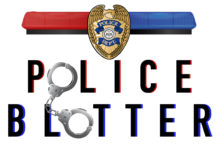A SRU alumna has developed a method that allows trace evidence examiners to identify remnants of cosmetic preservatives when there is contact between victim and suspect. Emily Myers, 2013 graduate of forensic chemistry with a minor in criminology, presented her graduate research on November 19, 2014 at the Eastern Analytical Symposium (EAS) Conference in Somerset, New Jersey.
“I have developed a method to determine multiple preservatives in cosmetic and personal care products using a liquid chromatograph-tandem mass spectrometer,” Myers said.
The EAS is the second largest conference and symposium on analytical chemistry in the United States. Over 4,000 scientists from the U.S. and the international community attend the conference annually.
Preservatives are natural or synthetic ingredients added to products in order to prevent spoilage, microbial growth, undesirable chemical changes, and to extend the product’s shelf life, Myers said. The use of preservatives in personal care products is important because they prevent product damage from microorganisms and also help protect the product from unintentional contamination by consumers during use. Without the addition of preservatives the product may become contaminated leading to product degradation and in the case of cosmetic foundations for example, potentially increase the risk of irritation or infection.
“From a forensic standpoint, cosmetics especially are easily transferred in a crime when there is contact between victim and suspect,” Myers said. “The ability to discriminate and identify cosmetic foundations can be important in this aspect and the method that I developed will be an important tool for trace evidence examiners.”
Myers is a student in Cedar Crest College’s forensics program in Allentown, Pennsylvania. Cedar Crest is one of only three colleges in Pennsylvania with an accredited forensics program and one of four with an accredited master’s program. Myers said not a lot of schools get the opportunity to take students to conferences, let alone have them present their own research. One reason she chose Cedar Crest was because they are good at getting students’ names out.
Myers also gave an oral presentation at the 2014 Annual Meeting of Northeastern Association of Forensic Scientists (NEAFS) in Hershey, Pennsylvania, and was the recipient of the 2014 Carol DeForest Research Grant. Receiving the grant gives Myers lead way for purchasing supplies and makeup to further her investigations, she said.
“Cosmetics aren’t cheap,” Myers said. “The grant allows me to fund my research with more variability without being restricted to a budget.”
Feb. 16 through 21, Myers will be attending the 67th American Academy of Forensic Sciences Meeting to exhibit research in Orlando, Florida. She will perform a poster presentation for a few hours while defending and answering questions from professionals, Myers said. On the days she is not presenting, she plans to attend other professional presentations, preferably about trace and crime scene.
“The conferences I have attended this far have been very beneficial experiences to say the least,” Myers said. “Not only have I been given the opportunity to present my research, I have also been able to converse one on one with many professionals within the field not only about my research but about the profession in general.”
Myers got to where she is today when she realized she didn’t want to be stuck in a classroom or a lab. She previously thought about teaching but quickly realized it wasn’t the career path for her, Myers said.
“I went with the most interesting path by declaring forensic and taking on criminal justice,” Myers said. “I developed an interest in crime scene rather than chemistry.”
Myers hopes to move out of state because a lot of the Pennyslyvania laboratories don’t offer scientists the opportunity to go out in the field, it is more police based. The west coast allows chemists to be a part of the crime unit, Myers said.
“I plan on attending more professional conferences in the future and look forward to expanding my knowledge in the field of forensic science,” Myers said.







